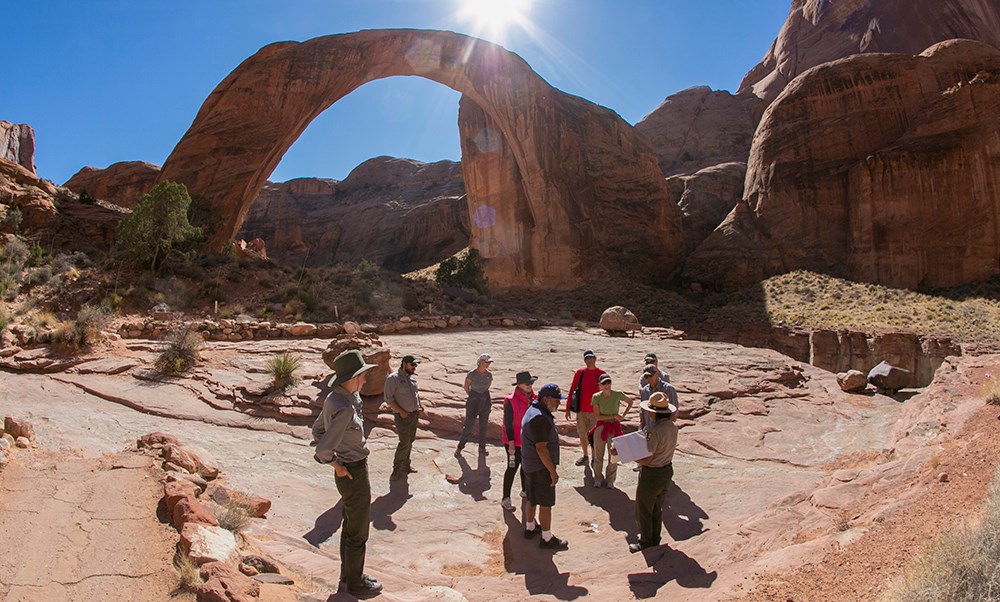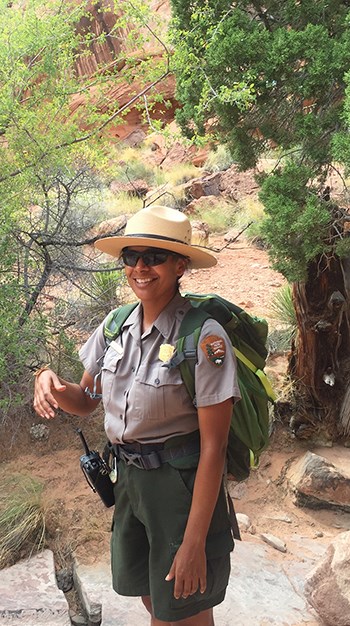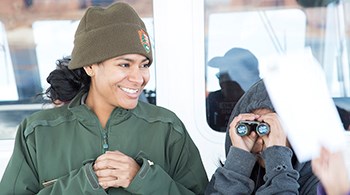Last updated: February 1, 2023
Article
Ranger Edmonia-Making Your Own History

NPS / Brent&Dawn Davis
Standing in Glen Canyon National Recreation Area's desert landscape, a visitor will likely pick out a few simple things at first glance: some grasses, shrubs, lots of rock and sand, and Lake Powell, of course.
In the summertime one will likely see lots of other visitors. There are people fishing, boating on Lake Powell, walking out to Horseshoe Bend, and others meandering around the Glen Canyon Dam. Others are taking in the cycles of time revealed in the massive expanse of sandstone and geologic features that vividly occupy the landscape. These are the iconic features for which National Parks are known and celebrated.
Some visitors might be interested in experiencing the rich histories Glen Canyon National Recreation Area preserves. John Wesley Powell's 1869 journey down the Colorado River, the 1776 crossing of the father's Dominguez and Escalante, and the countless accounts of pioneers and settlers from the Church of Jesus Christ of Latter Day Saints (LDS) whose descendants still live in the area today.
Though not as visible, the inquisitive visitor can experience the diverse and complex histories of indigenous peoples, a history much older than American colonialism and still a living part of Navajo, Hopi, Paiute, Zuni, and Ute life today. In fact, on a thoughtful visit to Rainbow Bridge National Monument, Defiance House archeological site near Bullfrog, or Descending Sheep Panel along the river corridor, one can close their eyes and almost feel the past in the canyon’s protective embrace and the full force of the untamed river.

NPS
However, there is something the typical visitor likely won't see. Aside from international tourists, which have been absent since the onset of the global pandemic, a visitor to Glen Canyon will likely be able to count the number of non-white people they interact with one hand. Ironic, given the opposite will occur only a few miles outside Glen Canyon's borders in the town of Page, and surrounding Navajo Nation, with their mostly indigenous populations.
Personally, as an employee and weekend visitor to Glen Canyon, I don't see anyone that looks like me. I am an African American, indigenous Mexican, and Hispanic American woman whose ancestors migrated to the west in the late 1800s to escape racial discrimination after the civil war, and north in the early 1900s to escape the hardships of the Mexican revolution. While an ancestry like mine can be loosely related to Glen Canyon’s history, it’s hard to see myself in that history. Especially, when I don’t see people of color represented in the visitation or workforce. So, I sometimes ask myself, “Where does someone like me fit into the story of Glen Canyon?”
My connection to Glen Canyon is a personal one, founded in my love of the landscape. Growing up in the desert southwest, where open space and access to public lands is plentiful, I gained an appreciation for the ability to see distant horizons and the feeling of discovery that comes with it. This feeling of solitude and adventure surrounds me here in Glen Canyon. In 2015 when I was offered a position as a seasonal interpretive ranger here in Glen Canyon, after over ten years of living elsewhere, I jumped at the chance to return to the landscape that felt like home. I've worked at Glen Canyon ever since.
My presence here as a citizen of the 21st century may not be a historical one, told during campground ranger talks, or displayed in museum exhibits, but a piece of my history is here now. I've made my own history here. Hopefully the visitors that do not see themselves in the faces of fellow tourists, nor history preserved in Glen Canyon, will see me in my ranger uniform and see a piece of themselves here too.

NPS / Brent&Dawn Davis
This year, I invite you to boldly explore the places where you have not always been represented and make a new history for America as we move together to create a more inclusive country for us all. Add your own narrative to the history of our national parks and join us in preserving the special places that are part of the legacy and heritage of all Americans.
